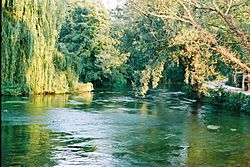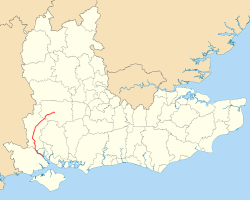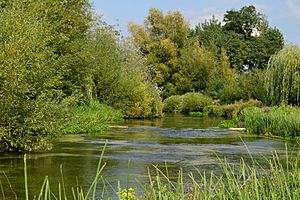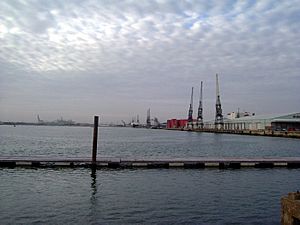River Test facts for kids
Quick facts for kids River Test |
|
|---|---|

The Test downstream of Sadler's Mill, Romsey
|
|

River Test highlighted in red, shown in South East England
|
|
| Country | England |
| Counties | Hampshire |
| Physical characteristics | |
| Main source | Ashe, near Overton, Hampshire, United Kingdom 90 m (300 ft) 51°14′43″N 1°14′21″W / 51.2454°N 1.2392°W |
| River mouth | Southampton water Southampton, Hampshire, United Kingdom 0 m (0 ft) 50°55′30″N 1°28′45″W / 50.9251°N 1.4792°W |
| Site of Special Scientific Interest | |

River Test at Tufton
|
|
| Area of Search | Hampshire |
|---|---|
| Interest | Biological |
| Area | 438.0 hectares (1,082 acres) |
| Notification | 1996 |
| Location map | Magic Map |
The River Test is a special kind of river called a chalk stream. It flows through Hampshire in the south of England. The river starts near Basingstoke at a place called Ashe. It then flows south for about 40 miles (64 km) until it reaches Southampton Water. Some towns along the River Test are Stockbridge and Romsey. There's also a long walking path called the Test Way that follows the river from the village of Longparish.
A large part of the River Test is a special protected area. This area is called a Site of Special Scientific Interest because of its amazing plants and animals. It is also part of a bigger protected area called the Solent and Southampton Water Ramsar site and Special Protection Area. People often go fly fishing for trout in the upper parts of the river.
Contents
What's in a Name? The River Test's History
The name of the River Test has changed over many years. In old records from 877 and 901, it was called "Terstan." Later, in 1045, it was known as "Tarstan stream," and in 1234, "Terstein." Finally, by 1425, it became "Test."
Some people think the name comes from an old language called Common Brittonic. If so, it might be linked to the Welsh words tres (meaning "tumult" or "uproar") or trais (meaning "force" or "might"). This suggests the river might have been known for its strong flow in the past.
Where Does the River Test Flow?

The River Test begins near the village of Ashe. This is about 10 kilometers (6 miles) west of Basingstoke. From there, it flows west through several villages like Overton and Laverstoke. It also passes through the town of Whitchurch.
After Whitchurch, the river meets the Bourne Rivulet at Testbourne. Here, it changes direction and starts flowing more to the south. It continues through villages such as Longparish and Middleton. Then, at Wherwell and Chilbolton, two other rivers, the River Dever and the River Anton, join the Test.
The river then flows past Leckford, Longstock, Stockbridge, and Houghton. It reaches Mottisfont and Kimbridge, where the River Dun adds its water. Next, it goes by Timsbury and through the land of Roke Manor before arriving at the town of Romsey. On the edge of Romsey, you can see Sadler's Mill, an old watermill from the 1700s, built right over the river.
South of Romsey, the Test flows past the large country house of Broadlands. It then goes by Nursling, which was once the site of a Roman bridge. Finally, the River Blackwater joins the Test. At this point, the river becomes tidal, meaning its water level changes with the ocean tides. It widens into a large area called an estuary. This estuary is lined with big container terminals and quays that belong to the Port of Southampton.
The Test estuary then meets the estuary of the River Itchen. Together, they flow into the sea as Southampton Water. Long ago, a canal called the Andover Canal ran next to the river between Chilbolton and Redbridge. This canal was later turned into a railway, which is now also gone. You can still see small parts of the old canal between Timsbury and Romsey.
Amazing Plants and Animals of the River Test
The River Test is a chalk stream, and these types of rivers are very special. The Test has some of the richest collections of plants and animals of any lowland river in England.
More than 100 different kinds of flowering plants have been found growing along its banks. Inside the river, scientists have recorded 232 different types of small creatures without backbones, called invertebrates. The river is also a very important home for wetland birds. Birds like kingfishers, grey wagtails, and little grebes all build their nests here.
How Healthy is the River Test's Water?
The Environment Agency checks the water quality of rivers in England. They give each river system an overall "ecological status." This status can be high, good, moderate, poor, or bad. To figure this out, they look at different things. For example, they check the types and numbers of invertebrates, flowering plants, and fish living in the river.
They also check the "chemical status" by measuring different chemicals in the water. This status is either "good" or "fail."
Here's how the River Test's water quality was in 2019:
| Section | Ecological Status |
Chemical Status |
Overall Status |
Length | Catchment | Channel |
|---|---|---|---|---|---|---|
| Test (Upper) | Good | Fail | Moderate | 14.803 km (9.198 mi) | 177.062 km2 (68.364 sq mi) | |
| Test - Bourne Rivulet to conf Dever | Good | Fail | Moderate | 8.286 km (5.149 mi) | 32.01 km2 (12.36 sq mi) | |
| Test - conf Dever to conf Anton | Good | Fail | Moderate | 3.869 km (2.404 mi) | 13.295 km2 (5.133 sq mi) | |
| Test - conf Anton to conf Dun | Good | Fail | Moderate | 28.075 km (17.445 mi) | 56.88 km2 (21.96 sq mi) | |
| Test - conf Dun to Tadburn Lake | Moderate | Fail | Moderate | 8.439 km (5.244 mi) | 19.045 km2 (7.353 sq mi) | heavily modified |
| Test (Lower) | Good | Fail | Moderate | 8.579 km (5.331 mi) | 3.91 km2 (1.51 sq mi) |
The River Test in Stories and Books
The River Test has appeared in a few famous books.
In You Only Live Twice, one of Ian Fleming's James Bond novels, James Bond's boss, M, mentions looking forward to two weeks of trout fishing on the Test.
The river also plays an important part in Richard Adams's 1972 novel Watership Down. In the story, a group of rabbits is being chased by enemies. One clever rabbit comes up with a plan to escape by floating down the Test on a small boat called a punt. The book explains that this plan worked because the River Test flows smoothly and doesn't have many weeds, unlike most rivers. The punt eventually gets stuck under a low bridge, and the rabbits have to swim underwater to reach the riverbank and escape.
Rivers That Join the Test: Tributaries
Many smaller rivers and streams flow into the River Test. These are called tributaries. Here are the main ones, listed from the mouth of the Test (where it meets Southampton Water) upstream:
- Tanner's Brook
- Wimpson stream (This stream now joins Tanner's Brook before reaching the Test because of changes to the docks.)
- River Blackwater
- River Dun
- Wallop Brook
- River Anton
- River Dever
- Bourne Rivulet
- River Swift
Images for kids


